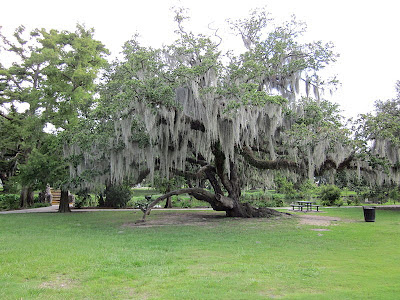 |
| A tree covered in Spanish moss (Tillandsia usneoides), also known as long moss, Florida moss, and graybeard. |
 |
| A Spanish moss flower |
Spanish moss has been used for various purposes both past and present. In the early days of automobiles, these plants would sometimes be used to stuff seats, and stuffing of furniture and mattresses was once incredibly common. In fact, many claimed that Spanish moss mattresses were preferable since they were cooler to sleep on than other types. Of course, keeping cool was very important in the days before air conditioning. Today, the plant is used for mulch and is a popular addition to arrangements of flowers, partly because it helps keep the flowers moist. Animals often use the plant for hiding and birds like to use it to build their nests. In addition, chiggers, which I have mentioned before, love to live in Spanish moss once it hits the ground. So, if you ever intend to stuff your mattress with graybeard, don't collect it from the ground or you will soon regret it!
Though Spanish moss is not parasitic, it can still be damaging to whatever tree it calls home since it can shade out the leaves.
Source is the University of Florida School of Forest Resources & Conservation. Images are from Wikimedia Commons under Creative Commons licenses: one, two.

This stuff is so cool. There's not a ton of it, but it grows here, that or something similar to it.
ReplyDeleteReally? I thought your area would be too cold for it.
DeleteIt doesn't grow anywhere I come from! Much too cold, especially this time of year!
ReplyDeleteIt looks so beautiful though. I've never seen it in person, even when I was on holiday in Florida, but I watched a reno program once in which a house in Florida was being given "curb appeal." There was a giant tree out front and it was covered in Spanish Moss... it was so beautiful. They, of course, removed every last trace of the stuff and cut away at many of the banches of the tree to make it more "clean" looking. I was sad, since I thought the yard had much more charm prior to them fixing it.
Of, that's such a shame! You may occasionally need to remove some moss if it starts taking over, but it really is gorgeous. And if that oak was a live oak, well, part of their charm is their lopsided beauty.
DeleteWhen we lived in Florida, we had century oaks in the yard and lots of Spanish moss. It would plop out of the trees onto the roof, or the car, or whatever. Looks pretty, but like the oaks, it's messy.
ReplyDeleteOh, yes it is. The chigger thing is also frustrating since if you aren't careful when you're tidying up after it's blown out of a tree you might end up with bites!
DeleteI currently have to park my car under an oak at it's constantly covered in sap, leaves, and acorns. There is also the occasional wisp of Spanish moss.